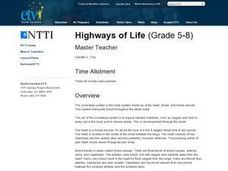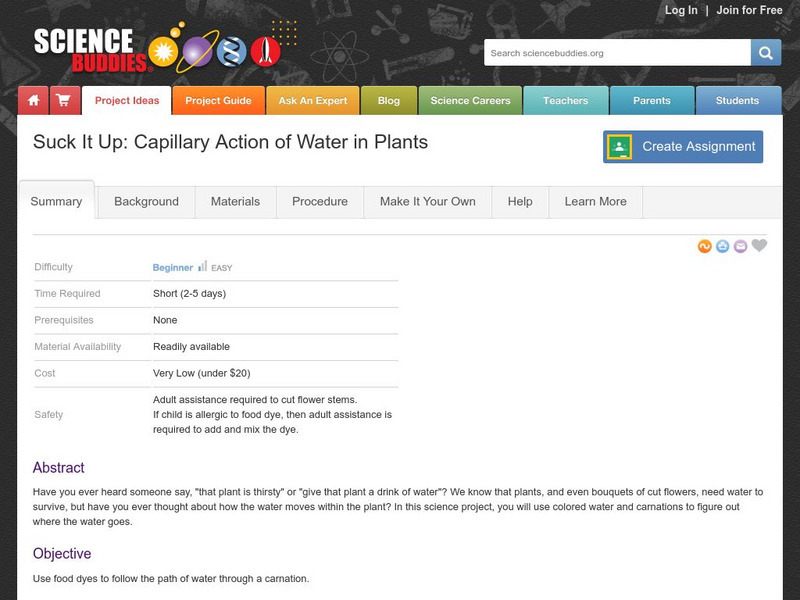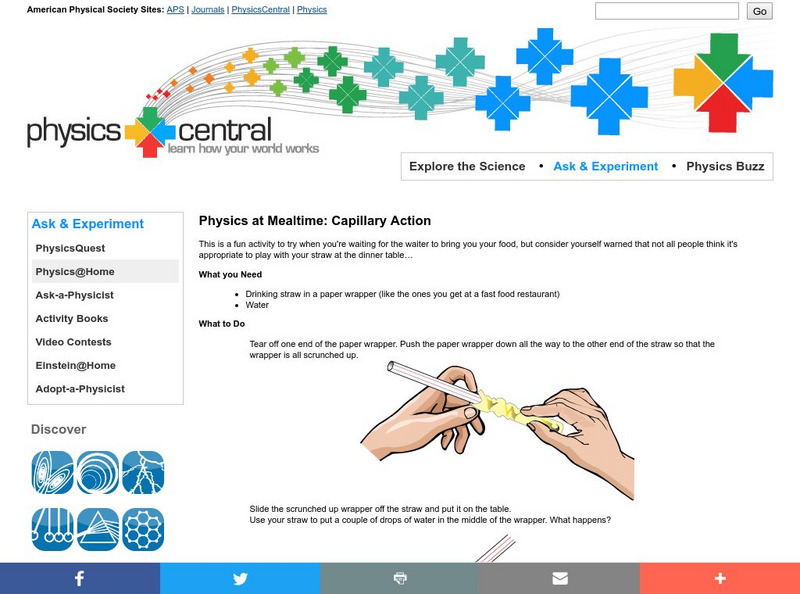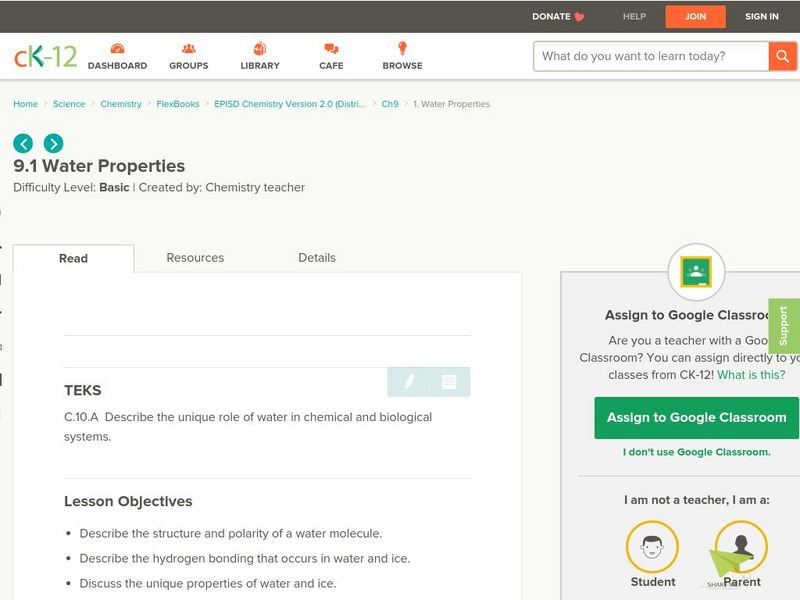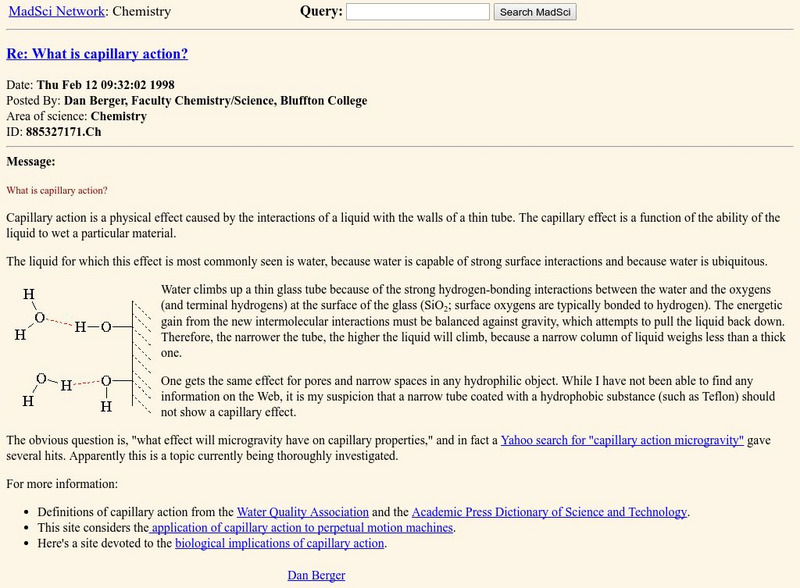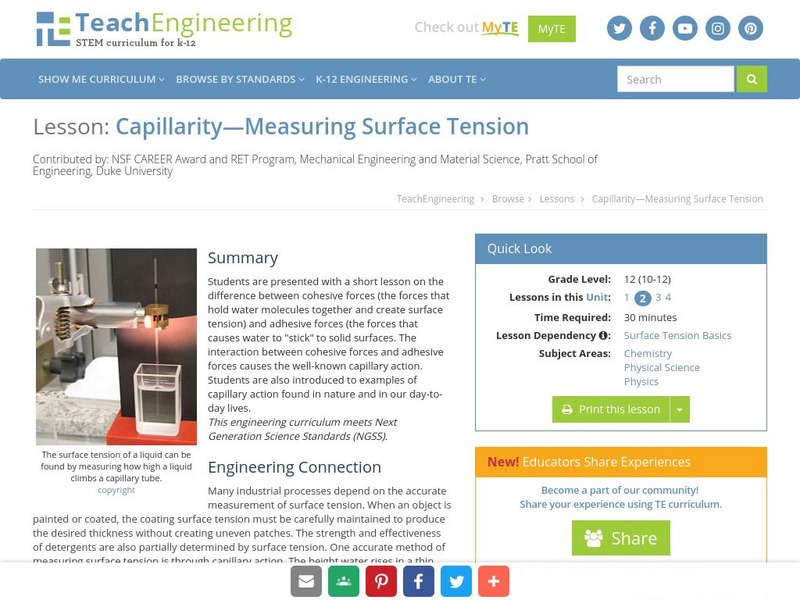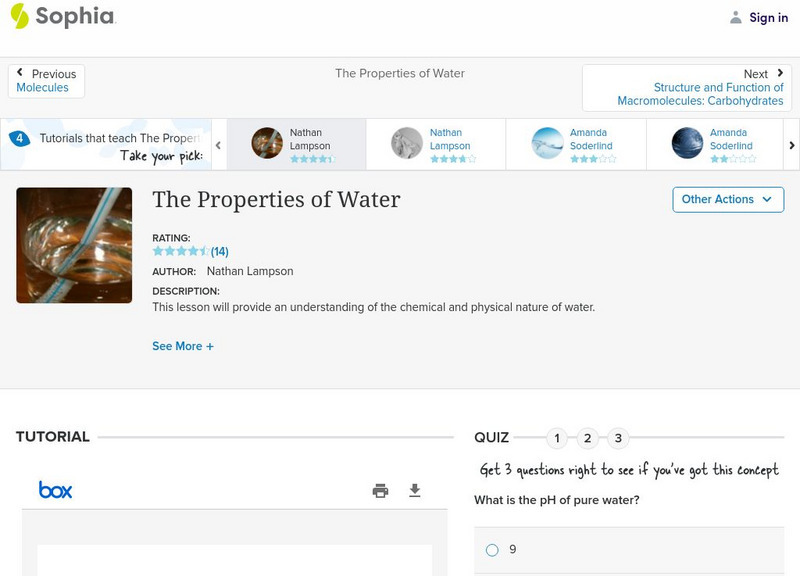Curated OER
Water - the (Nearly) Universal Solvent
In this solvent worksheet, students explore why water is considered a universal solvent. Students explore what can change dissolving rates. This worksheet has 8 matching, 3 short answer, 11 fill in the blank, and 4 problems to solve.
Curated OER
Redwood Trees: How Does Water Get to the Top of the Tree
Students discuss photosynthesis. They explore and discuss surface tension, hydrogen bonding and capillary action with hands on experiments. They make journal entries and draw pictures of the different stages of the experiments.
Curated OER
Plant Activities: Suck it up
Young scholars learn about the capillary process by doing a simple experiment with celery.
Curated OER
Forces in Liquids
In this forces in liquids learning exercise, learners read their notes and answer short answer questions about forces in liquids. Students complete 6 questions total.
Curated OER
The Root Show
Students investigate plant roots. In this plant lesson, students discover the function and structure of plant roots. Students plant a plant in a milk carton with a clear section cut out in order to observe the roots of the plant.
Curated OER
Paper Chromatography
Middle schoolers investigate the pigments in Magic Markers using chromatography. In this paper chromatography lesson plan, students use absorbent paper and mark the strip with a Magic Marker. They place the strip in a solvent and observe...
Curated OER
Stalactites And Stalagmites
Students conduct a scientific investigation about the formation of stalactites and stalagmites. They conduct an experiment to reproduce them in the lab environment. Students make observations over a period of time in order to see the...
Curated OER
Plant Pigments
Students investigate the components of chlorophyll. They use paper chromatography to separate the many pigments of chlorophyll from one another.
Curated OER
Plant Science: Introduction to Photosynthesis
Students explore the process of photosynthesis in plants. They discuss the purpose of photosynthesis and its components. Students discuss the importance of photosynthesis for plants and they examine the parts of the plant that play an...
Curated OER
How to tell when mealworms are out of breath
Students explore the respiration rate of a mealworm. Through experimental means, they determine the average volume of oxygen used and discuss factors that affect the respiration rate of an organism.
Curated OER
Separation of Unknowns in a Liquid
Students identify the different components of a given sample using chromatography. In this chemistry lesson, students compare paper and column chromatography. They collect data and construct data tables.
Curated OER
Properties
In this properties worksheet, students review the properties of solutions, explain different physical properties, define hydrogen bonding. This worksheet has 8 problems to solve.
Curated OER
Highways of Life
Young scholars explore the circulatory system. They participate in media activities to explore blood flow and identify the parts of the circulatory sytem. Students create a model of the circulatory system.
Curated OER
Separation of Unknowns in a Liquid
Students identify chromatography as method of separating the components of a liquid. Students discover that dyes are composed of more than one component in achieving a particular color in these lessons on paper chromatography.
Science Buddies
Science Buddies: Suck It Up: Capillary Action of Water in Plants
We know that plants, and even bouquets of cut flowers need water to survive, but we often do not think about how water moves within a plant. In this science project, you will use colored water and carnations to discover how water travels...
TeachEngineering
Teach Engineering: Exploring Capillary Action
Students observe multiple examples of capillary action. First they observe the shape of a glass-water meniscus and explain its shape in terms of the adhesive attraction of the water to the glass. Then they study capillary tubes and...
US Geological Survey
Usgs: Capillary Action
Capillary is described and explained. It is related to surface tension. Examples in botany and human physiology are given.
Physics Central
Physics Central: Physics at Mealtime: Capillary Action
An easy experiment that illustrates how water molecules move. Students will be able to conduct this activity quickly and easily and will only need a little liquid and a straw with a paper wrapper.
CK-12 Foundation
Ck 12: Water Properties
[Free Registration/Login may be required to access all resource tools.] In the following online tutorial students will describe the structure and polarity of a water molecule. They will also describe the hydrogen bonding that occurs in...
MadSci Network
The Mad Scientist Network: Chemistry/cappillary Action
Capillary action is described. Examples are illustrated. Links to related topics.
Other
Water on the Web
Water on the Web (WOW) is an advanced site allowing students to actively participate in data analysis from real research sites. Lesson plans on a range of topics are provided. There is also a tutorial for using Excel to graph WOW data.
TeachEngineering
Teach Engineering: Capillarity Measuring Surface Tension
Young scholars are presented with a short lesson on the difference between cohesive forces (the forces that hold water molecules together and create surface tension) and adhesive forces (the forces that causes water to "stick" to solid...
Sophia Learning
Sophia: The Properties of Water: Lesson 4
This lesson will provide an understanding of the chemical and physical nature of water. It is 4 of 4 in the series titled "The Properties of Water."
Sophia Learning
Sophia: The Properties of Water: Lesson 1
This lesson will provide an understanding of the chemical and physical nature of water. It is 1 of 4 in the series titled "The Properties of Water."












